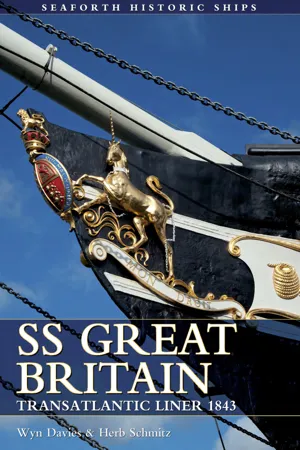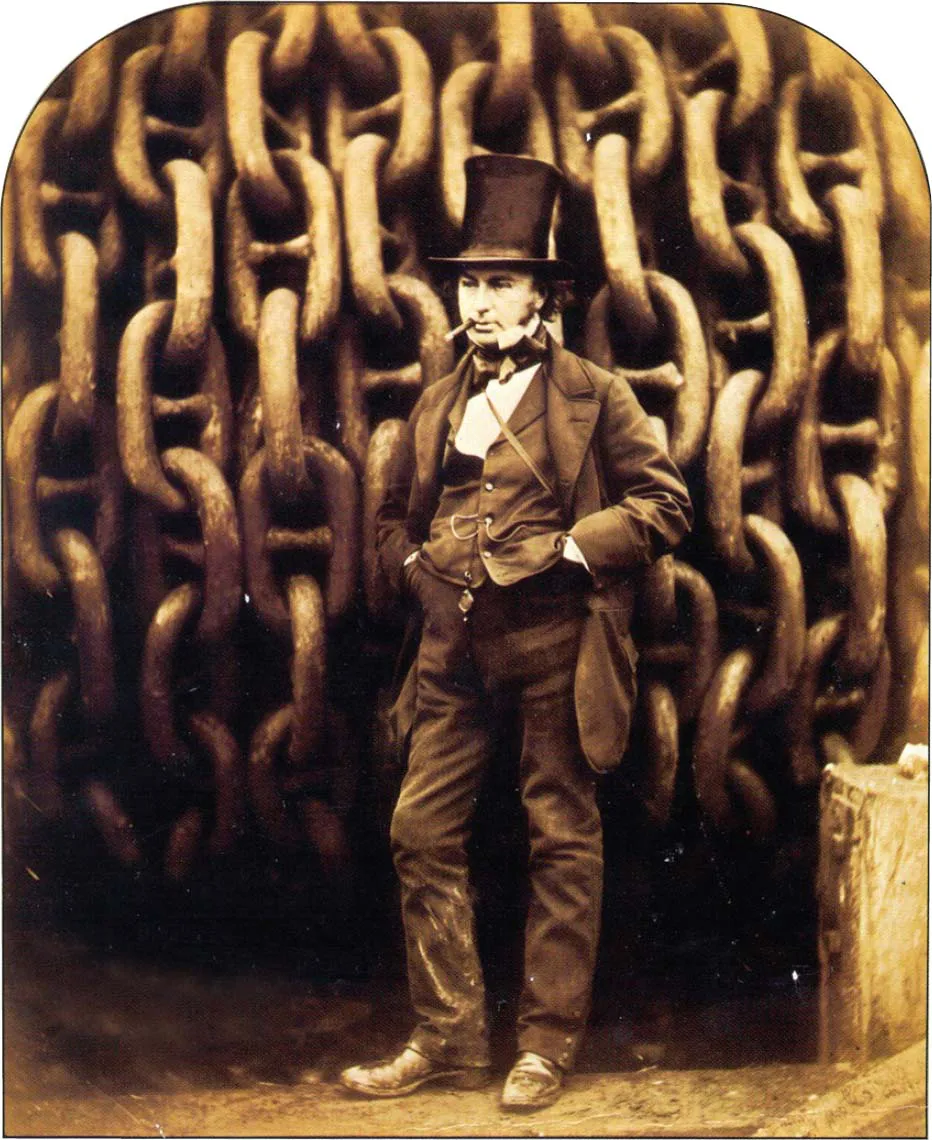![]()
1 INTRODUCTION
SOMEONE VISITING BRISTOL DOCKS IN 2012 for the first time in, say, ten years would find it hard to recognise the surroundings, such is the pace of change today; how much harder then would it be for the ghost of a certain Isambard Kingdom Brunel, returning after nearly 200 years to the city he did so much to promote. He might recognise some of Temple Meads railway station, and he would certainly still be able to see his suspension bridge, but were he to catch a glimpse of masts through the many new blocks of offices and flats, he would surely be a little mystified to find his other famous Bristol creation, the SS Great Britain, back in its original berth. Unique amongst heritage vessels preserved in Britain, the Great Britain has been restored and opened to an admiring public on the very spot where she was built.
![]()
Great Britain’s career began in 1843 and lasted until her abandonment in Sparrow Cove in the Falkland Islands in 1937, her internal decking having been removed to build a jetty at Port Stanley. In ninety years she underwent many modifications, and she is depicted here in 1846, her original six-masted schooner rig having been reduced to five masts to improve her balance. (The SS Great Britain Trust)
![]()
The largest ship in the world at her launch, built of a material many believed untried, and powered by the still relatively novel steam engine, it was typical of Brunel’s approach to things that she incorporated several firsts into her design.
Modern engineers are often encouraged to minimise or even eradicate untried features if they wish their project to succeed. Brunel would have none of this timidity. Perhaps fortunately, he was nearly always right and just as often had the force of character to get his proposals accepted. Equally, he was occasionally just that bit too far ahead of his time, and self-induced stress may have contributed to his early death during the building of his next ship, the Great Eastern.
In this book we will attempt to show that Brunel’s approach to the design of the Great Britain, whilst forward-looking, was still within the realms of what was possible with Britain’s growing industrial capabilities, and that his thinking was definitely more clear-sighted than many of his contemporaries, although he still needed his powers of persuasion from time to time. The result was a vessel which was a world beater at her launch.
![]()
2 BACKGROUND
ON STARTING THE RESEARCH FOR THIS BOOK there was an assumption that the design, build and career of Great Britain would be quite different to that of HMS Warrior, the author’s previous project. However, as the research progressed the more the similarities came out. Both vessels were pioneers in their field; both relied on the growing maturity of steam propulsion and iron manufacture; both were the largest of their type; both spent relatively little time at the task for which they were designed, and spent the majority of their service lives in a secondary role (perhaps stretching the analogy a bit as the Great Britain was very successful in her Australian role); both were hulked and both rescued from oblivion in the same decade. Of course, the Great Britain was the older of the two, by almost twenty years in conception and fifteen by launch date, so can perhaps lay greater claim to being a pioneer.
Another parallel was that both ships were, in part, conceived to overcome a threat to the country’s primacy from overseas. In the case of the Great Britain this was as a response to the winning of the bulk of the transatlantic passenger and mail trade by American packet boats. Their speed and relative reliability had drawn wealthy passengers away from the British merchant marine for some time, in an era when Britannia expected to be predominant. It took the Americans to produce the agency of their own downfall when their civil war led to the flight of their merchant ships to the British flag for protection against the depredations of Confederate commerce raiders, themselves mainly built in Britain! A situation from which, despite the enormous building programmes of the Second World War, they never fully recovered.
Returning to the Great Britain, the pioneering Great Western Railway had already been persuaded, probably mainly by Brunel, to in effect extend the railway from Bristol to New York by steamship. To this end the SS Great Western was commissioned from Brunel and put into service in 1837, whilst at the same time a sister-ship was being considered.
Like the Great Britain, the Great Western was built in Bristol, at the yard of William Patterson at Wapping, near the now home of the Bristol M-Shed Museum. Interestingly, the name Wapping seems to have migrated west along Spike Island as the Great Western Dock became known as the Wapping Wharf at some stage in its history. The Great Western’s structure illustrated Brunel’s striving for a long life for his creations. By standards then current, her structure more nearly reflects that of a warship than a merchant ship. Her framing was built up from futtocks (pieces of heavy timber) and bolted in pairs, but Brunel went further and bolted each pair directly together and then in larger groups along the whole length of the ship. This structure was caulked and made watertight before any of the actual planking was added. Such strength of structure was probably seen by Brunel as necessary to carry the vibration loads of a steam engine, and may have owed something to his continuing links with the Admiralty at the time, with the Surveyor’s office offering help and advice during the Great Western’s design.
Upon this immensely strong foundation were mounted the engines, from Maudsley, Son and Field, continuing Brunel’s longstanding relationship with them, although his assessment of the engine tenders and the final selection of Maudsley is a model of disinterest whilst admitting his relationship with the company. These engines drove two 28ft 9in (8.75m) diameter paddle wheels, which had to be installed on the Thames as they wouldn’t have fitted through Bristol’s dock gates.
![]()
A well-known photograph of Isambard Kingdom Brunel, standing before the launch chains of the Great Eastern, with his trademark stovepipe hat and cigar. (The SS Great Britain Trust)
![]() Despite being the largest of her type at her launch, the Great Western was in effect a relatively standard-outline paddle steamer and can be considered as a representative of a previous generation with her wooden structure. A few quick sums would show a modern naval architect that this wooden structure occupied some 36,700cu ft (just over 1000m3), most of which was lost cargo volume when compared with an iron-built ship. If we take the finding that Great Britain’s structure accounted for a quarter of her displacement and take the displacement of Great Western at 10ft draught as 1200 tons, an equivalent iron hull would weigh 300 tons or 305 tonnes and take up just 41m3. Obviously this is rather simplistic, but it clearly illustrates the advantage of iron over wood, which rapidly became apparent to shippers and shipowners alike.
Despite being the largest of her type at her launch, the Great Western was in effect a relatively standard-outline paddle steamer and can be considered as a representative of a previous generation with her wooden structure. A few quick sums would show a modern naval architect that this wooden structure occupied some 36,700cu ft (just over 1000m3), most of which was lost cargo volume when compared with an iron-built ship. If we take the finding that Great Britain’s structure accounted for a quarter of her displacement and take the displacement of Great Western at 10ft draught as 1200 tons, an equivalent iron hull would weigh 300 tons or 305 tonnes and take up just 41m3. Obviously this is rather simplistic, but it clearly illustrates the advantage of iron over wood, which rapidly became apparent to shippers and shipowners alike.![]()
On her first crossing of the Atlantic, Great Western arrived off New York on 23 April 1838 after a crossing of 15 days 12 hours (averaging 8.66 knots), thus beating the time of Sirius, the first steamship to carry passengers across the Atlantic, which had arrived only hours earlier. She can arguably be regarded as the first winner of the Blue Riband, the mythical and unofficial trophy for the fastest ship on the Atlantic. (The SS Great Britain Trust)
![]()
At this stage, the propulsion of the second ship was to have followed that of the Great Western and been by paddle wheel. Two things then occurred that almost certainly had a significant bearing on events. One was the visit to Bristol of the Archimedes, a screw propeller ship. Constructed by the Ship Propeller Company to demonstrate the virtues of screw propulsion, she was on a round-Britain voyage to test the propeller in service conditions. The Great Western Steamship Company (GWSC) directors borrowed her for some trials of their own, the results of which caused the building committee to decide to halt the paddle steamer design and get Brunel to prepare a report on the feasibility of using a propeller. At around the same time the Admiralty were to trial the propeller and had engaged Brunel as consultant. This led to the design and construction of HMS Rattler, of which more later.
Having satisfied himself of the economics of a steam-powered transatlantic service, Brunel had also proved to his satisfaction the economies of scale, that larger ships took less power for the same speed than simple scaling up all round would suggest. He was to take this to an apparent extreme with the Great Eastern, but as a first step the running mate to the Great Western was his next concern.
As will be described later, this project went through several turns of the design spiral before emerging as the Great Britain. The largest ship in the world at the time of her launch and for some time afterwards, she was constructed throughout of iron and powered by steam-driven screw propeller, a combination that set the precedent for the next hundred years, although steel eventually replaced iron for the main structure.
THE MERCHANT MARINE
To the modern reader the fact that British shipping once carried the bulk of world trade may come as something of a surprise. Not only did Britain supply the bulk of the shipping, but it also built the majority of the world’s ships, merchant or naval. This state of affairs was very much in embryo when Brunel was at work in Bristol, but what he started would last until the major losses of two World Wars finally unseated Britannia, in somewhat less time than it took to establish the position in the first place.
Whilst ships were built out of wood, anyone with a handy forest could do the job. Once the economies of using iron and later steel became apparent to the shippers, it was only those countries with a sufficiently developed industrial infrastructure which could build enough ships to meet the demand, and that was mainly Britai...



